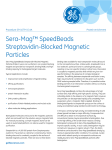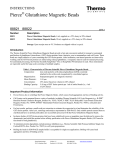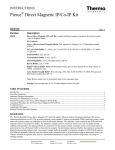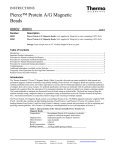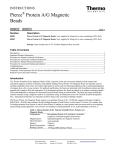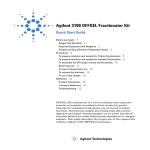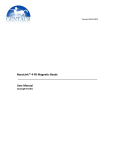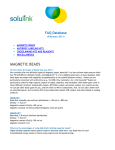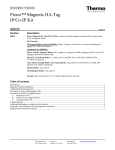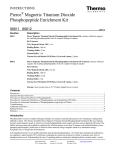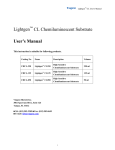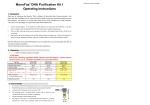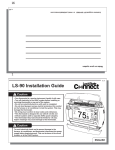Download Pierce Streptavidin Magnetic Beads - Fisher Scientific
Transcript
INSTRUCTIONS Pierce® Streptavidin Magnetic Beads 88816 88817 2077.1 Number Description 88816 Pierce Streptavidin Magnetic Beads, 1 ml, supplied at 10 mg/ml in water containing 0.05% NaN3 88817 Pierce Streptavidin Magnetic Beads, 5 ml, supplied at 10 mg/ml in water containing 0.05% NaN3 Storage: Upon receipt store at 4°C. Product is shipped on an ice pack. Table of Contents Introduction .................................................................................................................................................................................1 Important Product Information ....................................................................................................................................................2 Procedure for Manual Immunoprecipitation................................................................................................................................2 Procedure for Automated Immunoprecipitation ..........................................................................................................................3 General Troubleshooting .............................................................................................................................................................5 Frequently Asked Questions for the Thermo Scientific KingFisher Instrument..........................................................................5 Additional Information ................................................................................................................................................................5 Related Thermo Scientific Products ............................................................................................................................................6 Introduction The Thermo Scientific Pierce Streptavidin Magnetic Beads provide a fast and convenient method for manual or automated immunoprecipitation, protein interaction studies, DNA-protein pulldowns, and purification of biotin-labeled proteins and nucleic acids. Biotinylated molecules are simply added to the streptavidin-coated magnetic beads for binding. A magnetic stand is used for manually removing the beads from the solution. For automated processing, the Thermo Scientific KingFisher® Flex or KingFisher 96 Instrument is used. These instruments are especially useful for large-scale screening of multiple samples. Pierce Streptavidin Magnetic Beads use a recombinant form of streptavidin with a mass of 53 kDa and a near-neutral isoelectric point (pI). The protein is covalently coupled to the surface of the magnetic beads. For each streptavidin molecule on the bead, there are ~3 biotin-binding sites available. Unlike avidin, streptavidin has no carbohydrate groups, resulting in low nonspecific binding. Furthermore, the magnetic beads exhibit low nonspecific binding in the presence of complex biological samples such as cell lysates. The affinity between streptavidin and biotin is high, requiring harsh conditions for disruption. It is therefore possible to elute binding partners in an interaction complex without co-eluting the biotinylated component. Table 1. Characteristics of Thermo Scientific Pierce Streptavidin Magnetic Beads.* Composition: Streptavidin monolayer covalently coupled to magnetic bead surface Magnetization: Superparamagnetic (no magnetic memory) Mean Diameter: 1 µm (nominal) 2 g/cm3 Density: Bead Concentration: 10 mg/ml Binding Capacity: ~55 µg biotinylated rabbit IgG/mg of beads; ~3,500 pmol biotinylated fluorescein/mg of beads *Pierce Streptavidin Magnetic Beads are not supplied in RNase-free solutions. Pierce Biotechnology PO Box 117 (815) 968-0747 3747 N. Meridian Road Rockford, lL 61105 USA (815) 968-7316 fax www.thermo.com/pierce Important Product Information • Do not freeze or dry the Pierce Streptavidin Magnetic Beads. Freezing or drying will cause the beads to aggregate and lose binding activity. • After labeling proteins or nucleic acids with biotin, remove unincorporated biotin with a desalting column (e.g., Thermo Scientific Zeba Desalt Spin Columns, Product No. 89882-89894). Free biotin will reduce binding capacity. • To minimize protein degradation, include protease inhibitors (e.g., Thermo Scientific Halt Protease Inhibitor Single-Use Cocktail EDTA-free, Product No. 78425) in the preparation of cell lysate. • A low-pH elution may be used for single-use applications. To minimize streptavidin leaching, do not exceed 10 minutes for the elution step in either manual or automated protocols. • Boiling the magnetic beads in SDS-PAGE reducing sample buffer is acceptable for single-use applications. Boiling will cause bead aggregation and loss of binding activity. • The Pierce Streptavidin Magnetic Beads are compatible with mass spectrometry because of their low nonspecific binding. Procedure for Manual Immunoprecipitation A. Additional Materials Required • 1.5 ml microcentrifuge tubes • Binding/Wash Buffer: Tris-buffered saline (TBS, Product No. 28379) containing 0.1% Tween®-20 Detergent • Elution buffer: IgG Elution Buffer (Product No. 21004 or 21009) or 0.1 M glycine, pH 2-3 • Alternate elution buffer: SDS-PAGE reducing sample buffer • Biotinylated antibody • Antigen sample • Cell lysis buffer (used to prepare antigen sample) • Magnetic stand (e.g., Thermo Scientific MagnaBind Magnet for 6 × 1.5 ml Microcentrifuge Tubes, Product No. 21359) B. Pre-washing Pierce Streptavidin Magnetic Beads Note: To ensure homogeneity, mix the beads thoroughly before use by repeated inversion, gentle vortexing or using a rotating platform. 1. Add 50 µl (0.5 mg) of Pierce Streptavidin Magnetic Beads into a 1.5 ml microcentrifuge tube. 2. Place the tube into a magnetic stand to collect the beads against the side of the tube. Remove and discard the supernatant. 3. Add 1 ml of Binding/Wash Buffer to the tube. Invert the tube several times or vortex gently to mix. Collect the beads with a magnetic stand, then remove and discard the supernatant. Note: Do not allow beads to dry. If necessary, store beads in Binding/Wash buffer before proceeding with the purification protocol. C. Immunoprecipitation Note: This protocol is a general guideline for immunoprecipitation and will require optimization for each application. 1. Combine the antigen sample with 10 µg of biotinylated antibody. Incubate 1-2 hours at room temperature or overnight at 4°C with mixing. Note: Dilute each sample to a minimum volume of 300 µl with cell lysis buffer or Binding/Wash Buffer. 2. Add the antigen sample/biotinylated antibody mixture to a 1.5 ml microcentrifuge tube containing pre-washed magnetic beads (see Section B above) and incubate at room temperature for 1 hour with mixing. 3. Collect the beads with a magnetic stand and remove and save the supernatant for analysis. Pierce Biotechnology PO Box 117 (815) 968-0747 3747 N. Meridian Road Rockford, lL 61105 USA (815) 968-7316 fax 2 www.thermo.com/pierce 4. Add 300 µl of Binding/Wash Buffer to the tube and gently mix. Collect the beads and then discard the supernatant. Repeat this wash twice. 5. Elution Buffer Recovery of Antigen: Add 100 µl of Elution Buffer to the tube. Incubate the tube at room temperature with mixing for 5 minutes. Magnetically separate the beads and save the supernatant containing target antigen. Note: If a low pH elution buffer is selected for elution, streptavidin leaching might occur. Low pH elution buffers are effective for most antibody-antigen interactions; however, to ensure efficient release of target antigen from the antibody, pre-rinse the beads with 300 µl 0.1% Tween-20 in water (no buffering capacity) before adding Low pH Elution Buffer. Alternate Elution: SDS-PAGE Reducing Sample Buffer Recovery of Antigen: Add 100 µl of SDS-PAGE reducing sample buffer to the tube and heat the samples at 96-100˚C in a heating block for 5 minutes. Magnetically separate the beads and save the supernatant containing target antigen. Note: If SDS-PAGE buffer is selected for elution, the eluate will contain streptavidin monomers and dimers and biotinylated antibody along with target antigen. Note: Use the Thermo Scientific Clean-Blot IP Detection Reagent (Product No. 21230 or 21233) to prevent detection of the immunoprecipitation antibody in Western blots. Procedure for Automated Immunoprecipitation A. Additional Materials Required • KingFisher Flex with 96 Deep Well Head (Product No. 5400630) or KingFisher 96 (Product No. 5400500) Instrument • Thermo Scientific Microtiter Deep Well 96 Plate, V-bottom, polypropylene (Product No. 95040450) • KingFisher Flex 96 Tip Comb for Deep Well Magnets (Product No. 97002534) • 1.5 ml microcentrifuge tubes • Binding/Wash Buffer: Tris-buffered saline (TBS, Product No. 28379) containing 0.1% Tween-20 Detergent • Elution Buffer: IgG Elution Buffer (Product No. 21004 or 21009) or 0.1 M glycine, pH 2-3 • Alternative Elution Buffer: SDS-PAGE reducing sample buffer • Antigen sample • Biotinylated antibody B. Preparation of the KingFisher Instrument and Plate Set-up Note: The following protocol is for general use with the KingFisher Flex or KingFisher 96 Instrument. Modify the protocol as needed using the Thermo Scientific BindIt Software provided with the instrument. 1. Combine antigen sample with 10 µg of biotinylated antibody per sample. Incubate 1-2 hours at room temperature or overnight at 4˚C with mixing. 2. Download the “SA immunoprecipitation low pH elution” or “SA immunoprecipitation heated elution” protocol from the web site (www.thermo.com/kingfisher) into the BindIt™ Software on an external computer. 3. Transfer the protocol to the KingFisher Flex or KingFisher 96 Instrument from an external computer. See the BindIt Software User Manual for detailed instructions on importing protocols. 4. Set up the plates according to Table 2. Pierce Biotechnology PO Box 117 (815) 968-0747 3747 N. Meridian Road Rockford, lL 61105 USA (815) 968-7316 fax 3 www.thermo.com/pierce Table 2. Pipetting instructions for the immunoprecipitation protocol. Plate # Plate Name Plate Type Content Volume Streptavidin Beads 50 µl 1 Beads Microtiter Deep Well 96 Plate Binding/Wash Buffer 150 µl 2 Bead Wash Microtiter Deep Well 96 Plate Binding/Wash Buffer 1,000 µl Antibody/Antigen 3 Antigen Sample Microtiter Deep Well 96 Plate 300 µl Sample 4 Wash 1 Microtiter Deep Well 96 Plate Binding/Wash Buffer 300 µl 5 Wash 2 Microtiter Deep Well 96 Plate Binding/Wash Buffer 300 µl 6 Wash 3 Microtiter Deep Well 96 Plate Binding/Wash Buffer 300 µl Low-pH Elution Elution Buffer 7 Microtiter Deep Well 96 Plate 100 µl SDS-PAGE Reducing Heated Elution Sample Buffer KingFisher Flex 96 Tip Comb for Deep Well 8 Tip Plate Microtiter Deep Well 96 Plate Magnets *To ensure efficient release of target antigen from the antibody, replace the buffer used in Wash 3 (plate # 6) with 0.1% Tween-20 Detergent in water (no buffering capacity). Notes: • If using less than 96 wells, fill the same wells in each plate. For example, if using wells A1 through A12, use these same wells in all plates. • To ensure bead homogeneity, mix the vial thoroughly by repeated inversion, gentle vortexing or rotating platform before adding the beads to Plate 1. • Combine the Tip Comb with a Deep Well 96 Plate. See the instrument user manual for detailed instructions. • The beads can be eluted into 100 µl of 0.1 M glycine, pH 2-3 or 100 µl SDS-PAGE reducing sample buffer. If using the SDS-PAGE reducing sample buffer, install the KingFisher Flex or 96 Heating Block (see manual for proper installation). • If SDS-PAGE buffer is selected for elution, the eluate will contain streptavidin monomers and dimers and biotinylated antibody combined with target antigen. • If a low-pH elution buffer is selected for elution, streptavidin might leach from the beads. Low-pH elution buffers are effective for most antibody-antigen interactions. C. Executing the SA Automated Immunoprecipitation Protocol 1. Select the protocol using the arrow keys in the instrument keypad and press Start. See the KingFisher Flex or KingFisher 96 User Manual for detailed information. 2. Slide open the door of the instrument’s protective cover. 3. Load the plates into the instrument according to the protocol request, placing each plate in the same orientation. Confirm each action by pressing Start. 4. After the samples are processed, remove the plates as instructed by the instrument’s display. Press Start after removing each plate. 5. Press Stop after all plates are removed. Pierce Biotechnology PO Box 117 (815) 968-0747 3747 N. Meridian Road Rockford, lL 61105 USA (815) 968-7316 fax 4 www.thermo.com/pierce General Troubleshooting Problem Low protein recovery Possible Cause Proteolysis of sample Not enough magnetic beads used for capture Protein does not elute Insufficient amount of target protein in the sample Elution conditions were too mild Multiple, nonspecific bands appear in eluted sample Recovered protein is inactive Nonspecific protein binding to the magnetic beads Elution conditions were too stringent Magnetic beads aggregate Magnetic beads were frozen or centrifuged The buffer was incompatible with magnetic beads Solution Add protease inhibitors Increase the amount of magnetic beads used for capture Increase amount of antigen sample Increase incubation time with elution buffer or use more stringent elution buffer Add 50-200 mM NaCl to the Binding/Wash and Elution Buffers Use a milder elution buffer (e.g., Thermo Scientific Gentle Elution Buffer, Product No. 21034) Handle the beads as directed in the instructions Frequently Asked Questions for the KingFisher Instrument Question Answer Which plates are compatible with KingFisher Flex and KingFisher 96 Instruments? The KingFisher Flex Instrument is compatible with the KingFisher 24 Deep Well plates, Microtiter Deep Well 96 Plates, KingFisher 96 Plates and 96 PCR Plates. The KingFisher 96 Instrument is compatible with the Microtiter 96 Deep Well Plates, KingFisher 96 Plates and 96 PCR plates. Is it possible to concentrate samples during the run? Both deep well plates and KingFisher 96 Plates can be used during the same run. Therefore, it is possible to start the processing by using larger volumes (in a deep well plate) and eluting the purified sample to a smaller volume (in a KingFisher 96 Plate). Is it possible to heat the samples during the run? The heating block is located inside the instrument and can be used automatically during the sample process. All plates compatible with the KingFisher Flex Instrument can be heated using specially designed, interchangeable heating blocks. Why do the beads stick to the plastic tips and wells or the eluted proteins sticks to the wells? Proteins conjugated to beads and eluted proteins can nonspecifically bind to plastics. Adding detergent in the Binding/Wash Buffer prevents the protein conjugated to the beads from sticking (0.05%-0.1% Tween-20 Detergent). Also include a small amount of detergent in the Elution Buffer (e.g., 0.05% Tween-20 Detergent) or silanize the elution plate. Are the reagent volumes in each well critical? For best results, keep the specified volumes within defined limits to avoid spillover. Additional Information • Visit www.thermo.com/pierce for additional information including the following: o Tech Tip # 43: Protein Stability and Storage • Visit www.thermo.com/kingfisher for information on KingFisher Products. • In the U.S.A., purchase KingFisher Supplies from VWR. Contact your local Thermo Fisher Scientific office to purchase KingFisher Supplies outside the U.S.A. Pierce Biotechnology PO Box 117 (815) 968-0747 3747 N. Meridian Road Rockford, lL 61105 USA (815) 968-7316 fax 5 www.thermo.com/pierce Related Thermo Scientific Products 88800, 88801 Pierce Protein A Magnetic Beads 88806, 88807 Pierce Protein G Magnetic Beads 88821, 88822 Pierce Glutathione Magnetic Beads 88811, 88812 Pierce Magnetic TiO2 Phosphopeptide Enrichment Kit 24615 Imperial™ Protein Stain, 1 L, sufficient for up to 50 mini gels 34075 SuperSignal® West Dura Extended Duration Substrate, sufficient for 1,000 cm2 of membrane 25200-25244 Precise Protein Gels, see catalog or web site for a complete listing 21955 EZ-Link® Micro NHS-PEO4-Biotinylation Kit Reference 1. Chaiet, I. and Wolf, F.J. (1964). The properties of streptavidin, a biotin-binding protein produced by Streptomycetes. Arch Biochem Biophys 106:1-5. Tween® is a registered trademark of ICI Americas. SuperSignal® Technology is protected by U.S. Patent # 6,432,662. This product (“Product”) is warranted to operate or perform substantially in conformance with published Product specifications in effect at the time of sale, as set forth in the Product documentation, specifications and/or accompanying package inserts (“Documentation”) and to be free from defects in material and workmanship. Unless otherwise expressly authorized in writing, Products are supplied for research use only. No claim of suitability for use in applications regulated by FDA is made. The warranty provided herein is valid only when used by properly trained individuals. Unless otherwise stated in the Documentation, this warranty is limited to one year from date of shipment when the Product is subjected to normal, proper and intended usage. This warranty does not extend to anyone other than the original purchaser of the Product (“Buyer”). No other warranties, express or implied, are granted, including without limitation, implied warranties of merchantability, fitness for any particular purpose, or non infringement. Buyer’s exclusive remedy for non-conforming Products during the warranty period is limited to replacement of or refund for the non-conforming Product(s). There is no obligation to replace Products as the result of (i) accident, disaster or event of force majeure, (ii) misuse, fault or negligence of or by Buyer, (iii) use of the Products in a manner for which they were not designed, or (iv) improper storage and handling of the Products. Current versions of product instructions are available at www.thermo.com/pierce. For a faxed copy, call 800-874-3723 or contact your local distributor. © 2009 Thermo Fisher Scientific Inc. All rights reserved. Unless otherwise indicated, all trademarks are property of Thermo Fisher Scientific Inc. and its subsidiaries. Printed in the USA. Pierce Biotechnology PO Box 117 (815) 968-0747 3747 N. Meridian Road Rockford, lL 61105 USA (815) 968-7316 fax 6 www.thermo.com/pierce






